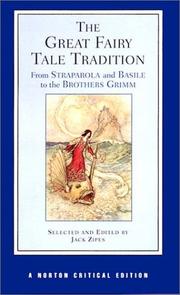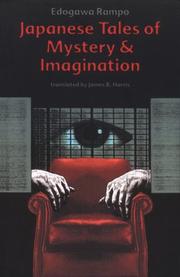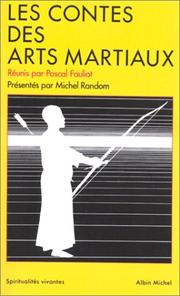| Listing 1 - 10 of 15 | << page >> |
Sort by
|
Book
ISBN: 2716901716 9782716901710 Year: 1983 Publisher: Paris: Publications orientalistes de France,
Abstract | Keywords | Export | Availability | Bookmark
 Loading...
Loading...Choose an application
- Reference Manager
- EndNote
- RefWorks (Direct export to RefWorks)

ISBN: 039397636X Year: 2001 Publisher: New York ; London Norton
Abstract | Keywords | Export | Availability | Bookmark
 Loading...
Loading...Choose an application
- Reference Manager
- EndNote
- RefWorks (Direct export to RefWorks)
Contes de fées --- Fairy tales --- Fées [Contes de ] --- Sprookjes --- Tales [Fairy ] --- Fairytales --- Children's stories --- Tales --- History and criticism

ISBN: 0804803196 4805311932 1462900615 Year: 1971 Publisher: Tokyo Tuttle
Abstract | Keywords | Export | Availability | Bookmark
 Loading...
Loading...Choose an application
- Reference Manager
- EndNote
- RefWorks (Direct export to RefWorks)
Book
ISBN: 9780231184472 0231184476 9780231184465 0231184468 9780231545501 0231545509 Year: 2018 Publisher: La Vergne Columbia University Press
Abstract | Keywords | Export | Availability | Bookmark
 Loading...
Loading...Choose an application
- Reference Manager
- EndNote
- RefWorks (Direct export to RefWorks)
Monsters, Animals, and Other Worlds is a collection of twenty-five medieval Japanese tales of border crossings and the fantastic, featuring demons, samurai, talking animals, amorous plants, and journeys to supernatural realms. The most comprehensive compendium of short medieval Japanese fiction in English, Monsters, Animals, and Other Worlds illuminates a rich world of literary, Buddhist, and visual culture largely unknown today outside of Japan.These stories, called otogizōshi, or Muromachi tales (named after the Muromachi period, 1337 to 1573), date from approximately the fourteenth through seventeenth centuries. Often richly illustrated in a painted-scroll format, these vernacular stories frequently express Buddhist beliefs and provide the practical knowledge and moral education required to navigate medieval Japanese society. The otogizōshi represent a major turning point in the history of Japanese literature. They bring together many earlier types of narrative—court tales, military accounts, anecdotes, and stories about the divine origins of shrines and temples––joining book genres with parlor arts and the culture of itinerant storytellers and performers. The works presented here are organized into three thematically overlapping sections titled, “Monsters, Warriors, and Journeys to Other Worlds,” “Buddhist Tales,” and “Interspecies Affairs.” Each translation is prefaced by a short introduction, and the book features images from the original scroll paintings, illustrated manuscripts, and printed books.
Otogi-zōshi. --- Japanese fiction --- Japanese prose literature --- Otogi-zZoshi. --- Otogi-zoshi --- J5620 --- J5924 --- Japan: Literature -- folk tales, fairy tales, mukashibanashi, ghost stories --- Japan: Literature -- premodern fiction and prose -- Kamakura and Chūsei in general (1185-1600) --- E-books
Book
ISBN: 271430835X Year: 2003 Volume: 23 Publisher: Paris : Corti,
Abstract | Keywords | Export | Availability | Bookmark
 Loading...
Loading...Choose an application
- Reference Manager
- EndNote
- RefWorks (Direct export to RefWorks)
Animals in literature --- Animals in poetry --- Animaux dans la littérature --- Animaux dans la poésie --- Beast epic --- Contes de fées --- Dieren in de literatuur --- Dieren in de poëzie --- Dierenepiek --- Dierenepos --- Dierenfabels --- Dierenromans --- Dierensprookjes --- Dierenverhalen --- Epopées animales --- Fables ésopiques --- Fairy tales --- Fées [Contes de ] --- Gedaanteverwisseling in de literatuur --- Metamorphose dans la litterature --- Metamorphosis in literature --- Sprookjes --- Tales [Fairy ] --- France
Book
ISBN: 0674576357 Year: 1973 Publisher: Cambridge Harvard university
Abstract | Keywords | Export | Availability | Bookmark
 Loading...
Loading...Choose an application
- Reference Manager
- EndNote
- RefWorks (Direct export to RefWorks)
J1872 --- J1890 --- J5610 --- J5620 --- S35/1022 --- Legends, Buddhist --- #SML: Joseph Spae --- Legends --- Japan: Religion -- Buddhism -- Hossō, Yuishiki --- Japan: Religion -- Buddhism -- literature --- Japan: Literature -- story telling, oral literature --- Japan: Literature -- folk tales, fairy tales, mukashibanashi, ghost stories --- Japan--Buddhism: sacred texts (incl. commentaries) see also 37/ --- Buddhist legends. --- Buddhist legends
Book
ISBN: 9784916055804 4916055802 Year: 2017 Publisher: Tokyo Japan publishing industry foundation for culture
Abstract | Keywords | Export | Availability | Bookmark
 Loading...
Loading...Choose an application
- Reference Manager
- EndNote
- RefWorks (Direct export to RefWorks)
"Since ancient times, the Japanese have lived with superstitions of strange presences and phenomena known as "yōkai," creating a culture by turns infused with unease, fear, and divinity. Tsukimono spirit possessions. Fearsome kappa, oni, and tengu. Yamauba crones. Ghostly yūrei. Otherworldly ijin ... Where did they come from? Why do they remain so popular? Written by Japan's premier scholar of yōkai and strange tales, this book is both an introduction to the rich imagination and spirituality of Japan's yōkai culture and a history of the authors and writings that have shaped yōkai studies as a field"--Back cover.
J1723.80 --- J5620 --- Japan: Religion in general -- demonology --- Japan: Literature -- folk tales, fairy tales, mukashibanashi, ghost stories --- Yōkai (Japanese folklore). --- Animals, Mythical --- Demonology --- Ghosts --- Monsters --- Folklore --- Ungeheuer. --- Dämon. --- Geister. --- Fee. --- Monstres --- Esprits. --- Démonologie. --- Bestiaires (genre littéraire) --- Créatures fabuleuses. --- Mythologie japonaise. --- Fantastique. --- Japan.
Book
ISBN: 9022833461 Year: 1979 Publisher: Haarlem : Fibula-Van Dishoeck,
Abstract | Keywords | Export | Availability | Bookmark
 Loading...
Loading...Choose an application
- Reference Manager
- EndNote
- RefWorks (Direct export to RefWorks)
Folklore --- Japanese language --- Asian literature --- Aziatische letterkunde. --- Bloemlezing. --- J5620 --- J1947 --- J1890 --- Japan: Literature -- folk tales, fairy tales, mukashibanashi, ghost stories --- Japan: Religion -- Shintō -- sacred writings, teachings --- Japan: Religion -- Buddhism -- literature --- J1912.10 --- Japan: Religion -- Shintō -- sacred writings, teachings -- histories, mythologies --- Japan

ISBN: 2226021205 9782226021205 Year: 1988 Volume: 45 Publisher: Paris: Albin Michel,
Abstract | Keywords | Export | Availability | Bookmark
 Loading...
Loading...Choose an application
- Reference Manager
- EndNote
- RefWorks (Direct export to RefWorks)
Arts martiaux --- S18/0350 --- S16/0250 --- J5620 --- J4202.10 --- China: Music and sports--Wushu, martial arts --- China: Literature and theatrical art--Popular poetry, folksongs, storytelling --- Japan: Literature -- folk tales, fairy tales, mukashibanashi, ghost stories --- Japan: Sociology and anthropology -- communities -- social classes and groups -- samurai, bushi
Book
ISBN: 9780520271029 9780520271012 9780520959125 0520271017 0520271025 0520959124 Year: 2015 Publisher: Oakland, California
Abstract | Keywords | Export | Availability | Bookmark
 Loading...
Loading...Choose an application
- Reference Manager
- EndNote
- RefWorks (Direct export to RefWorks)
Monsters, ghosts, fantastic beings, and supernatural phenomena of all sorts haunt the folklore and popular culture of Japan. Broadly labeled yokai, these creatures come in infinite shapes and sizes, from tengu mountain goblins and kappa water spirits to shape-shifting foxes and long-tongued ceiling-lickers. Currently popular in anime, manga, film, and computer games, many yokai originated in local legends, folktales, and regional ghost stories. Drawing on years of research in Japan, Michael Dylan Foster unpacks the history and cultural context of yokai, tracing their roots, interpreting their meanings, and introducing people who have hunted them through the ages. In this delightful and accessible narrative, readers will explore the roles played by these mysterious beings within Japanese culture and will also learn of their abundance and variety through detailed entries, some with original illustrations, on more than fifty individual creatures. The Book of Yokai provides a lively excursion into Japanese folklore and its ever-expanding influence on global popular culture. It also invites readers to examine how people create, transmit, and collect folklore, and how they make sense of the mysteries in the world around them. By exploring yokai as a concept, we can better understand broader processes of tradition, innovation, storytelling, and individual and communal creativity.
Yōkai (Japanese folklore) --- J1723.80 --- J5620 --- Japan: Religion in general -- demonology --- Japan: Literature -- folk tales, fairy tales, mukashibanashi, ghost stories --- Folklore --- Monsters --- Yōkai (Japanese folklore). --- SOCIAL SCIENCE --- Ungeheuer. --- Dämon. --- Volksglaube. --- Yōkai. --- Mythologie japonaise. --- Folktro. --- Folklore & Mythology. --- Japan. --- Japon. --- ancient folktales. --- anime. --- anthropology. --- asian mythology. --- concept of yokai. --- cultural reference. --- film. --- historical context. --- japanese folklore. --- japanese history. --- kappa water spirit. --- kitsune. --- long tongued ceiling licker. --- manga. --- monster guide. --- mountain goblins. --- shape-shifting foxes. --- yokai.
| Listing 1 - 10 of 15 | << page >> |
Sort by
|

 Search
Search Feedback
Feedback About UniCat
About UniCat  Help
Help News
News